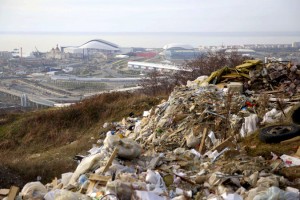I decided to read up on the environmental impacts that this year’s Winter Olympics in Sochi would have and, given the incessant talk on how expensive ($51 billion) the staging of the games have been, I was surprised to find out how poorly Russia kept to its promise of sustainability.
According to this first article, by Kharunya Paramagru, published in TIME: “As part of its bid, Russia told IOC members it would be staging a “zero waste” Games that followed green building standards.” However, it turns out that Sochi, one of the most biodiverse regions in Russia, has suffered due to “illegal waste dumping, construction that has blocked the migration routes of animals such as the brown bear, limited access to drinking water for locals and a generally decreased quality of life for many in the city of Sochi.”
Furthermore, in this next article, by Andrew E. Kramer, published in The New York Times, Kramer addresses the arrests of two ecologists, one of which was charged with “swearing in public.” In reality, however, Yevgeny Vitishko, one of the arrested ecologists and “author of a report…on environmental damaged caused by Olympic construction,” was arrested and sentenced to 15 days in jail before completing the report meant to be published before the start of the games.
Igor Kharchenko, an environmental activist, was also sentenced to a five day stay in jail, but was charged with “disobeying a police officer on a street near the route of the Olympic torch relay.”
A third environmental activist, Yulia Naberezhnaya, received a call from the Federal Security Service regarding whether she planned to stage a protest. She mentions that she plans to leave before she too is sentenced to a stay in jail.
Clearly, while environmental activists and ecologists have done their research on Russia and found numerous causes for distress in regards to the handling of the games in Sochi, Russian officials have done the same as it concerns identifying potential threats to Russia’s reputation.
The image above, taken from the New York Times article, portrays some of the illegal dumping that was done during construction of the site for the games.

Recent Comments